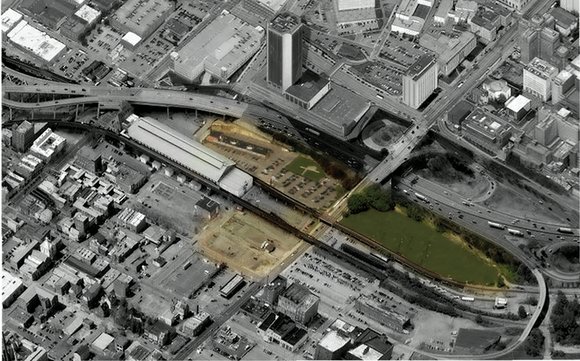Groups unite for slavery memorial in Shockoe Bottom
6/3/2016, 11:36 a.m.
By Malik Russell
The push to create a memorial to slavery in Shockoe Bottom took another step forward this week as national groups joined with local activists.
The National Trust for Historic Preservation and Dr. Max Page of the University of Massachusetts Center for Design Engagement are collaborating with the Sacred Ground Historical Reclamation Project to hold a series of community meetings this week that will culminate in a new and sharper proposal for the Shockoe Bottom slavery memorial.
The groups will reveal the proposals 5:30 p.m. Friday, June 3, at the Black History Museum & Cultural Center of Virginia, 122 W. Leigh St., in Richmond’s Jackson Ward. The meeting is open to the public.
“This is not just a local Richmond story. It’s also compelling as a national story,” said Dr. Page. “I think it is probably the most important undiscovered or untold site about slavery and its lasting impact up to the present.”
Others agree. The National Trust for Historic Preservation has named Shockoe Bottom “a national treasure.”
“A unique part of American history happened at Shockoe Bottom and it has nearly been forgotten,” said Rob Nieweg, senior field director and attorney for the national trust. “Shockoe Bottom should be treated as a site of conscience, a place where modern-day discussions can go on about the legacy of slavery and the things impacting our communities today. We see it both as an extremely important place for the past but also for its role in the future.”
The Massachusetts group started the process with plans previously generated by the Sacred Ground Historical Reclamation Project for the area in Shockoe Bottom that stretches between Interstate 95 east to the CSX Railroad tracks and train shed behind Main Street Station.
Activists are looking to create a memorial park on the 9-acre tract, which includes the Lumpkin’s Jail site, where thousands of enslaved people were held while being bought and sold, and the African Burial Ground that also held the Town Gallows where slave rebellion leader Gabriel was executed.
Two-thirds of the proposed park area already has been set aside by the city for a memorial. The national trust is suggesting addition of two square blocks east of the railroad tracks, between East Broad, 17th and East Grace streets.
The city has plans to revitalize 6 acres that includes Lumpkin’s Jail and the slave trail under the Richmond Slave Trail Commission. A larger plan for the area, proposed by Mayor Dwight C. Jones that included commercial development and a baseball stadium, collapsed under public opposition.
The key issue that worries advocates is whether there will be protections against commercial development around the site, which advocates want to remain reverent and respectful of the hundreds of thousands people whose lives were impacted by the slave trade.
Scores of slave trade and auction houses were in the Shockoe Bottom prior to the Civil War when Richmond’s slave trading industry ranked second only to New Orleans. Between 300,000 to 350,000 enslaved people were sold out of Virginia to support the cotton, tobacco and sugar cane industries.
Delegate Delores L. McQuinn, chair of the Slave Trail Commission that has $19 million in state and local commitments to create a memorial, said while the door for communication is open, no one invited her to this week’s community sessions, nor have there been conversations on ways to work together.
More importantly, she noted that the work of the Slave Trail Commission involving Lumpkin’s Jail and the African Burial Ground does not prevent the area from being expanded in any future plans.
She hinted that there will be a “big announcement” soon on the next phase of work at the Lumpkin’s Jail site.
Ana Edwards, chair of the Sacred Ground Historical Reclamation Project, said action by the Slave Trail Commission wouldn’t negate what the advocate groups are considering.
“They could go ahead with this, and that would be great,” she said of the commission’s proposals. “But we would like to see the full 9 acres protected.”
“This site in Shockoe Bottom is unique beyond compare in so many ways,” she said. “But it’s principally a place where you can not only find the slavery history but the black history origins in the state of Virginia and the city of Richmond that tie us to the rest of the national story.”
Advocates are looking to present their design proposals as alternatives the city would consider in response to public “Richmond Speaks” meetings the city held last year about the Lumpkin’s Jail site. The city has added the African Burial Grounds to its plan.
“It is important to understand that this is the land that we currently control,” city spokesperson Tammy Hawley said, noting the $19 million in financial commitments.
“This represents a level of financial support that this project has not had before and we are moving forward to build this site up to tell a fuller and more complete history of our city and our country,” she said.







